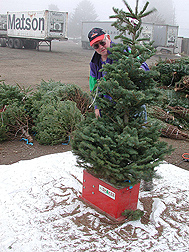Pest-Free Christmas Trees
|
|
When it comes to Christmas trees, Hawaii residents are just like residents on the mainland: They want the best trees they can get. But their quest to find the perfect tree could be hindered by pests, including yellowjackets, that hitch along for the ride from the Pacific Northwest to the Island State.
Although yellowjackets usually nest in the ground, mated queens who haven’t yet built their nests sometimes make Christmas trees their home during the winter. So, come November, when trees are rounded up for shipment to Hawaii, these queens get rounded up right along with them.
The western yellowjacket (Vespula pensylvanica) is an invasive insect that has already established itself throughout the Hawaiian islands. A voracious predator, it competes with native birds for insect prey, greatly reducing native insect populations. Scientists and regulators are particularly concerned because other yellowjacket species not yet established in Hawaii could also hitchhike in Christmas trees and cause ecological damage in their new home.
In an effort to keep more unwanted insects from getting to the islands, Hawaiian officials required exporters to screen for live insects by either manually shaking 10 percent of the trees in front of mainland agricultural inspectors or mechanically shaking 100 percent of the trees with no inspector present. Most growers opt for mechanical shaking, but there is no precise specification for how long the trees should be shaken—yet that makes a big difference in whether insects remain on the trees.
Entomologist Robert Hollingsworth, with the Pacific Basin Agricultural Research Center in Hilo, Hawaii, and colleagues from the Washington State University Puyallup Research and Extension Center, the University of Hawaii, and the Hawaii Department of Agriculture examined the efficacy and adequacy of the tree-shaking program. The scientists found that while mechanical shaking was significantly more effective than manual shaking, both methods failed to remove all yellowjacket queens from the trees.
Hollingsworth and colleagues tested the use of preharvest insecticide sprays as a supplement to the shaking treatment to further reduce the risk of exporting yellowjacket queens and other insects along with the Christmas trees. These results were more promising.
“We found that mist applications of an insecticide in the pyrethroid chemical class were 100-percent effective in killing yellowjacket queens and honey bee workers, which were used as surrogates for wasp pests,” explains Hollingsworth. “The residues of insecticides applied 1, 3, and 6 weeks before harvest were still effective in killing insects at harvest time, despite the heavy rainfall that occurred after spraying.”
Pyrethroids pose less risk to humans than many other insecticides, and products containing them are approved by the U.S. Environmental Protection Agency for use on Christmas and other ornamental trees. Some growers are already using them.
Following Hollingsworth’s study, and perhaps as a result of it, Hawaii now requires that all Christmas trees destined for the islands be shaken, regardless of shaking method. Future research plans include finding out how to make the shaking treatments more effective in the absence of an insecticide treatment.—By Stephanie Yao, Agricultural Research Service Information Staff.
This research is part of Crop Protection and Quarantine (#304) and Methyl Bromide Alternatives (#308), two ARS national programs described at www.nps.ars.usda.gov.
Robert Hollingsworth is in the USDA-ARS Tropical Crop and Commodity Protection Research Unit, Pacific Basin Agricultural Research Center, 64 Nowelo St., Hilo, HI 96720; (808) 959-4349.
"Pest-Free Christmas Trees" was published in the November/December 2010 issue of Agricultural Research magazine.







